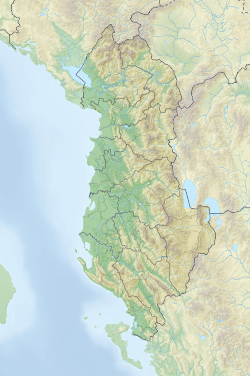Albanian Adriatic Sea Coast | |
|---|---|
 | |
| Coordinates: 40°20′10″N 19°27′46″E / 40.33611°N 19.46278°E | |
| Location | Adriatic Sea in Albania Balkan Peninsula |
| Dimensions | |
| • Length | 274 kilometres (170 mi) |
The Albanian Adriatic Sea Coast (Albanian pronunciation: [brɛˈɡdɛ:ti adriˈa:tik] — Albanian: Bregdeti Adriatik) stretches in the south-eastern Adriatic Sea beginning at the Gulf of Drin in the north, across the port cities of Shëngjin, Durrës, and Vlorë, to the Bay of Vlorë in the south, where the Albanian Riviera as well as the Albanian Ionian Sea Coast begins.
Albania is geographically located in Southern and South-eastern Europe within the Balkan Peninsula. It borders on Montenegro to the north-west, Kosovo to the north-east, North Macedonia to the east, Greece to the south, and the Mediterranean Sea to the west. The total length of the coastline is approximately 274 kilometres (170 mi), 178 kilometres (111 mi) of which are taken up by white sandy beaches and the remaining by different landforms.[1][2][3]
The Adriatic Sea is the northernmost arm of the Mediterranean Sea extending all the way from the Strait of Otranto in the south up to the Po Valley in the north.[4] The sea is apportioned into two major basins, wherein Albania is entirely located within the deepest and southernmost one. The coastline is one of the wealthiest scenery of the country in terms of biology, holding an outstanding diversity of ecosystems and biodiversity found within a precious mosaic of wetlands, estuaries, capes, sand dunes, marshlands, forests and marine habitats.
At different times, numerous ancient people, most notably the Illyrians[5][6] and later the Ancient Greeks and Romans, have established significant settlements around the shores. They were considerably influenced by their direct proximity to the sea because it provided routes for trade, colonization and war, as well as food; the Via Egnatia, that crossed through the mountains of Albania, was at that time among the most significant routes in the Roman Empire.
The coastline is populated by more than 1.5 million people. The most sizable cities are Durrës and Vlorë placed in the north and south, respectively.[7] Durrës is served by Port of Durrës, one of the largest on the Adriatic Sea, which connects the city to Italy and other neighbouring countries within the Adriatic.
- ^ Sustainable Development of Sea-Corridors and Coastal Waters: The TEN ECOPORT project in South East Europe (Chrysostomos Stylios, Tania Floqi, Jordan Marinski, Leonardo Damiani ed.). Springer. 2015-04-07. p. 85. ISBN 9783319113852.
- ^ Pano Niko, Frashe˛ri Alfred, Avdyli Bardhyl and Hoxhaj Fatos. "Impact of the Climate Change on Adriatic Sea Hydrology" (PDF). itc.upt.al. p. 385. Archived from the original (PDF) on 2017-10-03. Retrieved 2017-10-02.
{{cite web}}: CS1 maint: multiple names: authors list (link) - ^ "OUTLOOK ON SEAWATERS DYNAMICS AND GEOLOGICAL SETTING FACTORS FOR THE ALBANIAN ADRIATIC COASTLINE DEVELOPMENTS" (PDF). itc.upt.al. p. 1. Archived from the original (PDF) on 2017-10-03. Retrieved 2017-10-02.
- ^ "Adriatic Sea" (PDF). arctic.ucalgary.ca.
- ^ Cunliffe, Barry (2008). Europe Between the Oceans. Yale University Press. pp. 115–116. ISBN 978-0-300-11923-7.
- ^ Wilkes, John J. (1995). The Illyrians. Oxford: Blackwell Publishing. pp. 91–104. ISBN 0-631-19807-5.
- ^ "SOME CONSIDERATIONS ON SEAWATER-FRESHWATER RELATIONSHIP IN ALBANIAN COASTAL AREA" (PDF). igme.es. Tirana. p. 2.
© MMXXIII Rich X Search. We shall prevail. All rights reserved. Rich X Search


